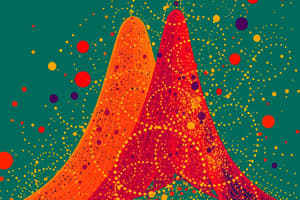Podcast
Questions and Answers
A discrete random variable can take on any value within a given range, including fractional values.
A discrete random variable can take on any value within a given range, including fractional values.
False (B)
The standard deviation is calculated by squaring the variance.
The standard deviation is calculated by squaring the variance.
False (B)
In a normal distribution, the mean, median, and mode are always unequal.
In a normal distribution, the mean, median, and mode are always unequal.
False (B)
A bar chart is the most appropriate type of graph to represent a probability distribution of a continuous random variable.
A bar chart is the most appropriate type of graph to represent a probability distribution of a continuous random variable.
The empirical rule states that for a normal distribution, approximately 95% of the data falls within one standard deviation of the mean.
The empirical rule states that for a normal distribution, approximately 95% of the data falls within one standard deviation of the mean.
The sample space is the set of all possible outcomes of random variable.
The sample space is the set of all possible outcomes of random variable.
Given the probability distribution:
X
0
1
2
3
P(X)
1/8
3/8
1/8
3/8
The mean ($$\mu$) is equal to 1.5.
Given the probability distribution:
| X | 0 | 1 | 2 | 3 |
|---|---|---|---|---|
| P(X) | 1/8 | 3/8 | 1/8 | 3/8 |
The mean ($$\mu$) is equal to 1.5.
If a normally distributed dataset has a variance of 9, then its standard deviation is 3.
If a normally distributed dataset has a variance of 9, then its standard deviation is 3.
Flashcards
Random Variable
Random Variable
A variable whose value is determined by the outcome of a random process.
Discrete Random Variable
Discrete Random Variable
A random variable that can take on a countable number of values.
Continuous Random Variable
Continuous Random Variable
A random variable that can take on an infinite number of values within a given range.
Normal Distribution
Normal Distribution
Signup and view all the flashcards
Properties of Normal Distribution
Properties of Normal Distribution
Signup and view all the flashcards
Mean
Mean
Signup and view all the flashcards
Variance
Variance
Signup and view all the flashcards
Standard Deviation
Standard Deviation
Signup and view all the flashcards
Study Notes
Random Variables
- Definition of a random variable
- Meaning of discrete and continuous random variables
- Shape of the normal probability distribution
- Properties of the normal distribution
- Types of graphs used in probability distributions
- How to construct a sample space
Mean, Variance, and Standard Deviation
- Symbols for mean, variance, and standard deviation
- Definition of mean, variance, and standard deviation
- Definition of a normal distribution
- Properties of a normal distribution
- Empirical rule distribution
Practice Problems
- A table of values for X and P(X)
- X values: 0, 1, 2, 3
- P(X) values: 1/8, 3/8, 1/8, 3/8
Formulas
- Mean: μ = Σ X • P(X)
- Variance: σ² = Σ (X - μ)² • P(X)
- Standard Deviation: σ = √σ²
Studying That Suits You
Use AI to generate personalized quizzes and flashcards to suit your learning preferences.




